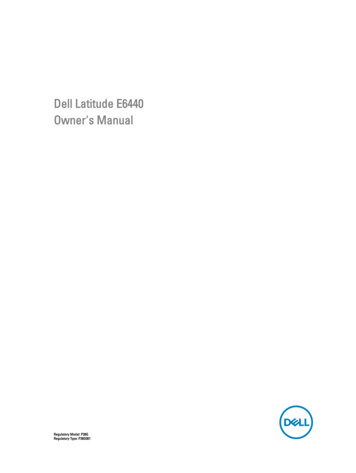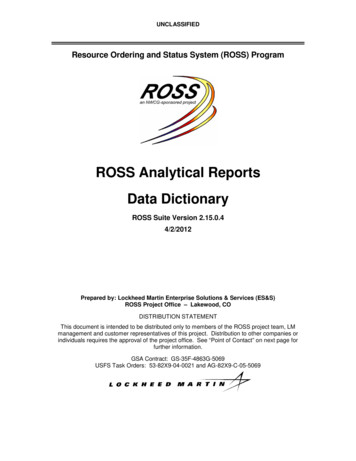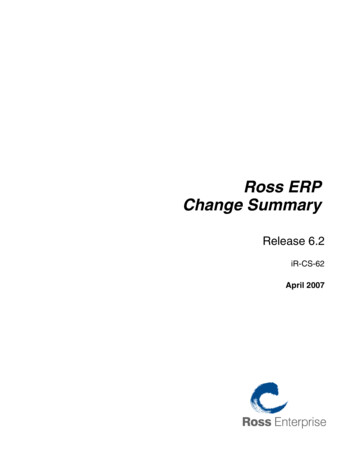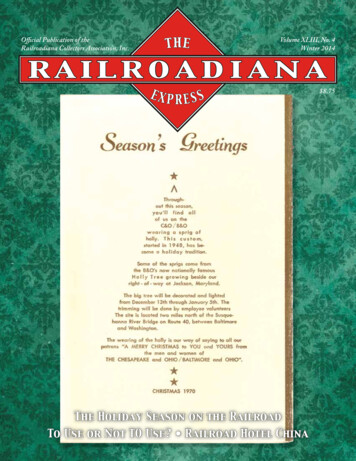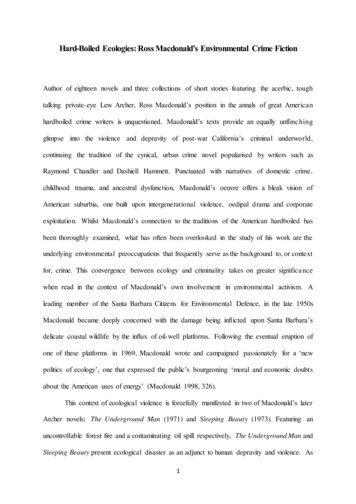
Transcription
Hard-Boiled Ecologies: Ross Macdonald’s Environmental Crime FictionAuthor of eighteen novels and three collections of short stories featuring the acerbic, toughtalking private-eye Lew Archer, Ross Macdonald’s position in the annals of great Americanhardboiled crime writers is unquestioned. Macdonald’s texts provide an equally unflinc hingglimpse into the violence and depravity of post-war California’s criminal underworld,continuing the tradition of the cynical, urban crime novel popularised by writers such asRaymond Chandler and Dashiell Hammett. Punctuated with narratives of domestic crime,childhood trauma, and ancestral dysfunction, Macdonald’s oeuvre offers a bleak vision ofAmerican suburbia, one built upon intergenerational violence, oedipal drama and corporateexploitation. Whilst Macdonald’s connection to the traditions of the American hardboiled hasbeen thoroughly examined, what has often been overlooked in the study of his work are theunderlying environmental preoccupations that frequently serve as the background to, or contextfor, crime. This convergence between ecology and criminality takes on greater significa ncewhen read in the context of Macdonald’s own involvement in environmental activism. Aleading member of the Santa Barbara Citizens for Environmental Defence, in the late 1950sMacdonald became deeply concerned with the damage being inflicted upon Santa Barbara’sdelicate coastal wildlife by the influx of oil-well platforms. Following the eventual eruption ofone of these platforms in 1969, Macdonald wrote and campaigned passionately for a ‘newpolitics of ecology’, one that expressed the public’s bourgeoning ‘moral and economic doubtsabout the American uses of energy’ (Macdonald 1998, 326).This context of ecological violence is forcefully manifested in two of Macdonald’s laterArcher novels; The Underground Man (1971) and Sleeping Beauty (1973). Featuring anuncontrollable forest fire and a contaminating oil spill respectively, The Underground Man andSleeping Beauty present ecological disaster as an adjunct to human depravity and violence. As1
such, this article argues that the damage and destruction inflicted upon the environment in thesetexts becomes symbiotically connected to the morally fraught social milieu of the city. Throughthe vehicle of the crime novel, Macdonald establishes a correlation between “nature and humannature”, as ‘the harm done to the fragile ecology’ ultimately materialises as the “consequenceof, and counterpart to, violations inflicted on other people” (Fine 2000, 132). This becomesmost explicitly dramatised in the theme of spoiled innocence, specifically in the parallelMacdonald draws between the damage inflicted upon delicate ecologies by a combination ofcorporate greed and human irresponsibility and the harm exacted upon children by equally selfserving and negligent parents. Within this, Macdonald’s work expresses a tension central tothe American pastoral: the longing for an idyllic landscape that is always in the process ofdisappearing.Pollution and Environment in the Hardboiled Crime NovelAmerican crime fiction has a long tradition of presenting warped families and abhorrentcriminal acts as a symptom of a broader pattern of cultural and environmental decline. In thedecaying and adulterated urban setting, the hardboiled detective typically attempts to combatthis entrenched and pernicious culture of corruption, even whilst it is perpetuated by the veryinstitutions and mechanisms designed to eradicate it. Although ecocritical readings ofhardboiled crime fiction are somewhat limited, many critics have acknowledged the genre’senduring preoccupation with ideas of pollution and contamination. The sprawling metropolisis frequently rendered as a “polluted wasteland”, one that threatens to “poison and corrupt”anyone who walks its mean streets, even the private eye himself (Scaggs 2005, 70). Scaggspoints to Dashiell Hammett’s Red Harvest as a novel that prefigures this connection betweencrime, contamination and the urban environment. After being called to the aptly namePoisonville to investigate the murder of newspaper publisher Donald Willsson, the Continenta l2
Op begins to sense that he is being slowly soiled by the violence and depravity of the city. “It’sthis damned town”, he tells Dinah Brand, ‘Poisonville is right. It’s poisoned me’ (Hammett2003, 156). As Scaggs suggests, the Continental Op’s fears of infection appear vindicated whenhe awakens the next morning holding an ice pick, the sharp end of which has been plunged intothe chest of the prostrate Dinah Brand.Scaggs also cites Raymond Chandler’s The Big Sleep as a text that exhibits similaranxieties about the polluted physical and moral topography of the city. As Marlowe gets drawndeeper into the sordid secrets of the Sternwood family, he too senses that he has becomeinfected by the “nastiness” of the city (Chandler 2011, 250). Yet Chandler’s novel alsoexamines a larger union between environmental pollution and the fraught cultural landscape ofSouthern California, most obviously through General Sternwood’s connection to the oilindustry. There are several descriptions in the text of the decaying oil wells where theSternwood’s made their fortune, a rotten wasteland of “stagnant, oil-scummed water”, “rustedmetal” and sagging structures (237, 242). Located outside of the city, these images of corrosionand despoliation emphasise the text’s examination of the connection between urban expansion,criminality and pastoral devastation. Sarah Trott focuses on several instances in Chandler’swork which emphasise a stark conflict between the “pastoral and the urban”, a tradition thatshe argues has captured the imagination of numerous American writers across genres (2016,102). She perceives Marlowe’s attempts to escape the “frenzied urban landscape” to the“peaceful pastoral” in Lady in the Lake and Playback as indicative of a broader “literary cryagainst the waves of dehumanizing modernity sweeping through the United states in the earlytwentieth century” (102).In The Lay of the Land, Annette Kolodny describes this ‘pastoral impulse’ as somethingunique to the American consciousness, principally because the “entire process” of frontierexpansion remains within “historical memory” (1975, 8). For Kolodny, this gives Americans3
the ability to “see themselves as the wilful exploiters of the very land that had once promisedan escape from such necessities” (8). Thus, not only is the “pastoral impulse neither terminatedor wholly repressed”, but the entire “dream and its betrayal, and the consequent guilt and anger”remain potent and corrosive forces in the American psyche (8). The inherent tensions andambiguities surrounding the “American pastoral”—I argue—are underexplored yet key facetsin Macdonald’s work and American hardboiled crime fiction more generally (Garrard 2012,54). Both The Underground Man and Sleeping Beauty not only elucidate this tension betweenrapid industrial development and the pastoral myth, but also are inundated with characters whopossess a profound sense of loss and guilt. This guilt – often manifested in the spoiledinnocence of youth - becomes intimately intertwined with a broader corrosion of the pastoralidyll.Indeed, the destructiveeffects of corporate consumptionand environme nta lexploitation are recurring themes that can be traced throughout all the Archer novels. Inmultiple guises, Macdonald presents an urban topography saturated by a rigid and violent formof individualism, one that has a detrimental impact on the fragile balance of families, societiesand ecosystems. As Robert Gale suggests, the overriding message of Macdonald’s writings is“that greed damages the environment, corrupts legitimate commercial enterprises, and—worstof all—wrecks loving human relationships” (2002 xi). One need only look at the second Archernovel, The Drowning Pool (1950), to gauge the ultimate trajectory of his work. Prefigur ingMacdonald’s fixation with the stark disconnect between corporate power and environme nta lresponsibility, The Drowning Pool revolves around the Pareco Oil Company’s attempts topurchase the land of wealthy matriarch Olivia Slocum, whose rural estate sits on top of alucrative oil reservoir. Despite pressure from her destitute and financially dependent son James,Olivia Slocum refuses to sell the property, seemingly due to the potentially damagingenvironmental consequences. In truth, Slocum’s motives are more racially and aesthetica lly4
driven than environmentally, as this feigned ecological concern disguises her real motive: “thatof keeping out the Mexicans and dirty oil-crew workers who damage the town’s prestige”(Weinkauf 1994, 87).Although the Slocums’ ultimate indifference towards environmental ethics becomesclear as the narrative progresses, Macdonald’s own anxieties regarding the rapid devastationof post-war California’s rural spaces are rendered palpable via Archer’s potent description ofNopal Valley’s desolate and festering landscape:The oil wells from which the sulphur gas rose crowded the slopes on both sides of thetown. I could see them from the highway as I drove in: the latticed triangles of thederricks where trees had grown, the oil-pumps nodding and clanking where cattle hadgrazed. Since ‘thirty-nine or ‘forty, when I had seen it last, the town had grownenormously, like a tumour. The main street had been transformed by glass brick, plastic,neon. (25)Archer provides an almost post-apocalyptic vision of a decaying wasteland forged by the jointventures of industrial expansion and land development. Broadening exponentially, theeconomic imperatives of capitalism are depicted as a destructive and cancerous growth, a“tumour” whose malignant tendrils metastasize violently across the rural landscape, devouring,destroying and leaving in their wake a barren wilderness of skeletal wildlife and acrid,carcinogenic smog. The city is the rotting corpse beneath the spectacle of glass brick andpulsating neon, the erstwhile natural entities of trees and cattle are erased and replaced by thepolluted signs of an unstoppable and pervasive consumerism. Situated directly before Archer’sfirst visit to the Slocum residence, there is an element of foreboding in this desolate image of5
ecological decline, one that is eventually mirrored in the equally contaminated dynamic of thefamily.After Olivia Slocum is discovered drowned in her pool, Archer unearths a festeringmaelstrom of betrayal, dishonesty and murder, a plot that implicates three generations of theSlocum family and leaves two women dead. Like the poisoned and desolate topography of thecity, by the denouement both “the family and the family place” have been equally andirreparably “corrupted” (Moore 2006, 262). The familial dynamic becomes inseparable fromthe corporate logic of the city, one that prioritises ruthless exploitation and greed overcooperation, community and coexistence. The moral thrust of The Drowning Pool becomesdemonstrably clear, as it is the Slocum family’s failure to “recognise and nurture” relationships,be they “ecological or familial in nature”, that ultimately catalyses such widespreaddisaffection and death (Witschi 2014, 386). Outside of Olivia Slocum’s murder, drowningproves a powerful central motif, signifying the family’s symbolic submersion in bottomlessdepths of greed and deception. Yet water itself emerges a source of potential purification, anidyllic entity that cannot be tarnished by Southern California’s toxic milieu. In a tranquilmoment when Archer cleanses his befouled psyche in the “long blue space” of the PacificOcean, he takes solace in the incorruptibility of the water. Peering out at the “jerrybuiltbeaches” and “superhighways” that have demolished and replaced “thousands of years ofredwood growth”, Archer still perceives the vast expanse of the ocean as impervious to thecontamination of anthropogenic pollutants. Ruminating on the rapid devastation of SouthernCalifornia’s pastoral landscape, he hopefully asserts: “They couldn’t touch the ocean. Theypoured their sewage into it, but it couldn’t be tainted” (23).This juxtaposition of California’s stark yet waning physical beauty with its vacuous andviolent social milieu is very much a reflection of Macdonald’s own tempestuous and waveringrelationship with his adopted Santa Barbara home. As pessimistic as Macdonald was about the6
Santa Barbara “cultural climate”, he found a certain solace in its natural tranquillity and beauty,particularly the “mind calming, soul-cleansing sea” (Nolan 1999, 282). The erection of anumber of Oil Well platforms off the Santa Barbara coast in the late 1950’s was therefore asource of great irritation and concern for Macdonald. He was a frequent and vocal detractor,publicly denouncing Union Oil and the U.S. Department of Interior for conspiring to sanctionillegal drilling in the channel without the requisite legal surveys and precautions.His growing frustration at such blatant political disregard towards matters ofconservation was further exacerbated in 1964, when Macdonald became heavily involved in abattle to prevent the building of a new road near the Los Padres National Forest. An avid birdwatcher, Macdonald was particularly concerned about the habitat of the near extinct Californiacondor. The woodland had previously acted as an unofficial sanctuary for the endangered birdand he feared that increased human intrusion would have a detrimental impact on itsconservation. Macdonald campaigned avidly to prevent the proposed developments, implor ingfellow writers and friends to speak out against what he perceived as a moral injustice (Nolan1999, 241). Macdonald’s protests began attracting considerable publicity, so much so that theU.S Forest Service eventually agreed to hold a public hearing to allow the people of SantaBarbara the chance to decide the future fate of the road, one that ended in stalemate and a delayof the plans.If this could be considered a small victory for Macdonald, then any optimism he mighthave harboured about the emergence of a more environmentally cognisant industrial andpolitical agenda was severely dented by the underwater eruption of Union Oil’s Platform A inFebruary 1969. Within a matter of days, millions of gallons of crude oil and noxious gasesspewed into the ocean, thickening into a slick that stretched over 600 miles across the city’scoastline. Swept on uncontrollably by tides and waves, the oil continued to flow for months,inflicting catastrophic damage on the channel’s coastal wildlife. Causing the death of thousands7
of birds, aquatic mammals and other fragile fauna, the oil spill was an environmental disasteron an unprecedented scale (Campbell 2008, 341). Describing the event as the “blowout heardaround the world”, Macdonald and wife Margaret once again spearheaded protests against oildrilling on the Santa Barbara coast (Macdonald 1998, 326). Although Macdonald had written,and continued to write, investigative and polemical pieces regarding the need for greater levelsof ecological awareness and intervention, it was this event that prompted his explicit moveme ntinto environmental fiction. Described by Macdonald as “subject matter books”, both TheUnderground Man (1971) and Sleeping Beauty (1973) signalled a new phase in the Archernovels, one that shifted the latent environmental anxieties of his previous texts to the narrativeforefront (Nelson & Avery 2016, 124).Innocence Lost: The Underground Man and Sleeping BeautyThe Underground Man offers a warped and cynical vision of the California dream, one in whichinstances of familial disintegration and corrupted youth become brutally projected against thecataclysmic destruction of California’s rural landscape. In the process, Macdonald presents uswith an older and more jaded Archer, who in excavating the hidden secrets of damaged anddestructive families, is confronted with his own equally disconnected existence. The novelopens with what Michael Kreyling (2005, 140) describes as “a strong premonition of disaster”,as the sleeping Archer is woken an ominous “rattle of leaves” and stifling flow of “hot wind”through his open bedroom window (Macdonald 1971, 7). Archer’s immediate exposure to theheat and decay of a “slightly used West Los Angeles” generates a portentous atmosphere ofimpending social and environmental ruin, a foreboding that is further compounded when heobserves the sickly discolouration of the morning sky, its perforated edges stained with a“yellowish tinge like cheap paper darkening at the edges” (7).8
This veil of apocalyptic anxiety is momentarily lifted when Archer meets RonnyBroadhurst, an inquisitive and solitary young boy from one of the downstairs apartments. Aftera hesitant approach, the boy proceeds to help Archer feed a group of scrub jays that have nestedin the courtyard of the apartment block. Birds have long been a feature of Macdonald’s novelsand the symbolism here is unambiguous. Macdonald foregrounds the moral undertones of thetext via this symbiotic cohabitation between nature and humanity, whilst simultaneo us lydrawing a forceful correlation between the vulnerability of the boy and the correspondingfragility of the birds. The relative tranquillity of the scene is soon ruptured by the manic energyof Ronny’s father, Stanley, a man in his twenties who appears to Archer like “a grown- upversion of the boy” with the same “impression of anxiety” (8). After bursting into the apartmentcourtyard and accusing his estranged wife of infidelity, Stanley whisks his son away to SantaTheresa, the home of the Broadhurst family and the site of a lucrative real estate developme nt.Like his marriage, Stanley’s volatile psyche is also in the process of fracturing. Obsessed withthe quest to find his own father who mysteriously disappeared when he was a boy, this Freudiantheme of parental absence is ironically duplicated via Stanley’s similar neglect of his own sonRonny. Persistent in the belief that this loss “robbed his life of its meaning” (21), ironically itis Stanley’s search itself that exacerbates the splintering of his already tortured subjectivity. Itis unsurprising when Stanley’s wife, Jean Broadhurst, appears at Archer’s apartment later thesame afternoon, expressing concern that she has not heard from either Stanley or Ronny. Heranxiety is further compounded by news of a vicious forest fire sweeping its away across theSanta Theresa hills.Archer and Jean Broadhurst proceed to search for Stanley at the home of his mother,Mrs Broadhurst, the owner of the lucrative Canyon Estates development. Their approach to theestate unmistakeably emphasises the sordid conjunction between land development, warpedfamily histories and environmental ruin. Like the Drowning Pool, the once untainted pastoral9
landscape has been divided up and swallowed by wealthy suburban homes, the repercussionsof which are vividly portended in images of fire, decay and impending combustion:The Broadhurst ranch lay between these houses and the fire. . Her private asphalt lanewound through acres of mature avocado trees. Their broad leaves were shrivelling andthe tips as if the fire had already reached them, darkening fruit hung down from theirbranches like hand grenades (32).Macdonald’s depiction of looming ecological catastrophe possesses an almost biblica linevitability, a punishment for past transgressions. The customarily lush leaves of the avocadotrees are sinisterly altered into gnarled and shrivelled husks as if already scorched by the intenseheat of the blaze. The “darkening” of the fruit itself further accentuates this image ofcontamination and death, symbolising not only the despoliation of the landscape but also thedepravity and corruption underlying both the Broadhurst family history and the Canyon Estatesdevelopment itself. Having utilised the language of war prior to this passage when comparingthe fire to the “flashes of heavy guns too far away to be heard”, the convergence between theavocados and “hand grenades” operates to extend this metaphor of intense conflict, whilst alsostressing the extent to which the environmental has been superseded by, and subsumed within,broader industrial and economic imperatives.The tragic repercussions of violence, greed and irresponsibility are no more evidentthan in the dark history that culminates in the death of Stanley Broadhurst and the simultaneo usinstigation of the fire. Like in most of Macdonald’s novels, it is the sins and transgressions ofparents that are revisited upon their children, a theme that becomes powerfully manifested inthe mutilation of the equally fragile mountain ecology. Unable to track down Stanley or Ronnyat the ranch, Archer’s search leads him to the family’s mountain cabin, a large and weathered10
redwood structure stained red “as if it had been splashed with blood” (38). This ominous imageof violence transpires to be hauntingly apt, as the cabin is soon revealed to be the site of twobloody murders and two burials, one historic, one recent. After finding Stanley Broadhurst’sparked car, it is not long before Archer discovers the young man’s “curled” and abandonedbody. Struck over the head with a pick-axe and then dumped in a shallow grave near thewooded surroundings of the house, the incongruity of the corpse in this idyllic forest sceneclearly signifies what Ralph Willett describes as “a disturbance within nature” (1996, 25). Thissense of disturbance is further compounded when Archer determines that it was Stanley’sdropped cigarillo that instigated the forest fire in the first place. Although ostensibly an act ofnegligence, on a larger level the fire emerges as a metaphor for the damage inflicted upon futuregenerations by the careless and selfish acts or crimes of those in the past. As well as instiga tingthe fire, Stanley’s death acts as the catalyst for a series of escalating revelations that slowlyunearth a fraught history of betrayal, infidelity and intergenerational conflict, one thatimplicates several interlocking families. This unravelling runs in tandem with the swellingferocity and intensity of the fire, as Macdonald establishes a clear reciprocity between theecological and the familial. In both cases, Macdonald demonstrates that acts of negligence and“human short-sightedness” invariably come with “harsh consequences”, both social andenvironmental (Bryson 2010, 169).With the young Ronny Broadhurst still missing, Archer’s investigation leads himthrough a host of other fracturing families and it is not long before he links the boy’sdisappearance to disaffectedteenagers Jerry Kilpatrickand Sue Crandall.Like theBroadhurst’s, the Kilpatrick’s have been similarly torn apart by dishonesty and furtivebetrayals. After being abandoned by his mother as a child, Jerry has since been under theguardianship of his father Brian, a real estate developer who symbolises the entrenchedcorruption and greed of the city’s corporate institutions. Disillusioned and angry at his father11
for losing his mother to Leo Broadhurst, Jerry strikes up a bond with Sue Crandall, anotherteenager who feels similarly alienated from her parents. The Crandalls are also implicated inthe novel’s complex intergenerational and interfamilial saga, representing another fracturedhousehold of “mismatched generations and mismatched DNA” (Kreyling 2005, 151).Archer eventually traces the missing teenagers to the Santa Theresa Marina, but isknocked unconscious by Jerry Kilpatrick before he can rescue the ‘kidnaped’ Ronny from thefleeing vessel. Through his subsequent inquiries into the damaged family histories of the rogueadolescents, Archer is alerted to the existence of a stark generational divide and profound senseof guilt. This is aptly surmised when a desperate Brian Kilpatrick attempts to understand themotivations for his son’s actions. Unable to do so, he asserts: “we’re losing a whole generatio n.They’re punishing us for bringing them into the world” (80). Yet Archer sees through thisrhetoric and understands that it is the noxious tendrils of past transgressions that have pollutedthe lives of those in the present. He uses the language of contamination near the climax of thenovel, when he eventually tracks the missing teenagers to the Bay Area of San Francisco. Aftertalking Sue Crandall out of jumping from the Golden Gate Bridge, he identifies the kidnappingas an attempt to “rescue Ronny from the adult world” (219). He ruminates that both teenagersultimately belong “to a generation whose elders had been poisoned, like the pelicans, with akind of moral DDT that damaged the lives of their young” (212).The ornithological metaphor reasserts the association between the tarnished innocenceof youth and the destruction of nature. Crucially, the overwhelming sense of guilt that saturatesthe novel becomes reflective not only of failed guardianship, but of a larger betrayal of thepastoral impulse. Like the rogue adolescents that find themselves forced to the periphery ofsociety, the destruction of the natural landscape pushes the pastoral idyll further and further tothe margins. Terry Gifford describes this tension between the pastoral idyll and therepercussions of industrial development as key to the American experience of landscape,12
arguing that “the anti-pastoral is, in sense, built into the American pastoral” from its origins(2014, 25). Citing Leo Marx’s, The Machine in the Garden, he describes how the pastoral mythis always bound by a counteractive force that “undermines the idyll” from within (25). Thisinherent tension between the “dream and its betrayal” is epitomised by Archer and thehardboiled detective novel more generally (Kolodny 8). Whilst Archer laments the destructionof the environment and loss of American innocence, he is still plugged into the technologic a land industrial mainframe of the city. Like Marlowe before him, Archer is continually drawnback to its dark ravages, a return that renders the pastoral an unattainable and ever recedingfantasy.After rescuing Ronny, Archer pieces together the fragmented and complex history ofthe murders. Although these revelations precipitate the further breakdown of multiple families,the novel ends on a more ambiguous and possibly conciliatory note. Following a downpour ofheavy rains that vanquish the fire but, in the process, further destabilise the city’s alreadydelicate ecology, Archer evacuates Jean and Ronny from the approaching flash floods. Drivingthrough the heavy rain—a sign of purification in the wake of the proceeding blaze of depravityand violent passions—Macdonald presents an almost complete pseudo-family unit. As Archerinwardly pleads that Ronny doesn’t repeat the same mistakes as his father, Jean reaches behindand gently touches the detective’s neck. Macdonald seems to be offering hope here—not onlyfor Archer—but for a whole generation of young people suffering from the moral andecological deficiencies of their elders. Yet, this sense of hope is simultaneously problematisedby the resounding image of the automobile, the veritable machine in the garden. A symbol ofthe city and technological development more broadly, the ending to the The Underground Mannot only signals the continuing threat to the natural environment, but also Archer’s own guiltand complicity in this process.13
The guilt and latent impact of past transgressions is a theme that Macdonald revisits inhis second environmental crime novel, Sleeping Beauty. The novel unambiguously interroga tesSanta Barbara’s disastrous, real-life oil spill, using ecological catastrophe to re-examine therelationship between California’s physical and psychic landscapes. Yet, Sleeping Beauty is adifferent kind of novel to The Underground Man, particularly in terms of pacing. As TomNolan suggests, whereas the latter “dances along” frantically “like a wildfire”, the former“oozes like the black tide, slow and inexorable” (329). Sleeping Beauty’s stifling atmosphereof pollution and contamination magnifies Macdonald’s nightmare vision of California touncharted proportions, as evidenced in its potently apocalyptic opening.Peering out of the aircraft window on his journey back from a vacation in Mexico,Archer is confronted with a seemingly endless vista of black, carcinogenic discharge spreadingexponentially across the previously sapphire Pacific Point coastline. In the middle of the slickstands a jagged oil platform, protruding out of the water like “the metal handle of a dagger thathad stabbed the world and made it spill black blood” (1). This violent image of a woundedearth gushing black blood has dual implications. It represents the literal damage exacted uponthe environment by the economic primacies of industrial capitalism, and can simultaneo us lybe interpreted as a symbol of the fetid and repressed family secrets that will soon bubble to thesurface and contaminate the lives of others.Archer avoids heading home to his Los Angeles apartment and instead drives straightto Pacific Point so that he can assess the damage of the spill in person. Met by a panoramicview of the “enormous slick spreading like premature night across the sea” (2), Archer proceedsto the beach where he encounters—alongside numerous “spectators”—a young womancradling a contaminated and dying bird.14
The surf was rising sluggishly. A black bird with a sharp beak was struggling init. The bird had orange-red eyes, which seemed to be burning with anger, but it was sofouled with oil that at first I didn’t recognise it as a western grebe.A woman in a white shirt and slacks waded in thigh-deep and picked it up,holding its head so that I wouldn’t peck her. I could see as she came back toward methat she was a handsome young woman with dark eyes as angry as the bird’s. (2)In a near duplication of the opening scene from the Underground Man, Macdonald once againdraws a clear confluence between the fragility of birds and the brittleness of youth. Like
points to Dashiell Hammett's Red Harvest as a novel that prefigures this connection between crime, contamination and the urban environment. After being called to the aptly name Poisonville to investigate the murder of newspaper publisher Donald Willsson, the Continental . 3 Op begins to sense that he is being slowly soiled by the violence and .

